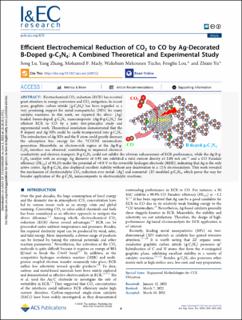| dc.contributor.author | Lu, Song | |
| dc.contributor.author | Zhang, Yang | |
| dc.contributor.author | Mady, Mohamed Fawzy Hamed Attia | |
| dc.contributor.author | Tucho, Wakshum Mekonnen | |
| dc.contributor.author | Lou, Fengliu | |
| dc.contributor.author | Yu, Zhixin | |
| dc.date.accessioned | 2023-02-17T14:22:51Z | |
| dc.date.available | 2023-02-17T14:22:51Z | |
| dc.date.created | 2022-04-19T19:18:31Z | |
| dc.date.issued | 2022 | |
| dc.identifier.citation | Efficient Electrochemical Reduction of CO2 to CO by Ag-Decorated B-Doped g-C3N4: A Combined Theoretical and Experimental Study | en_US |
| dc.identifier.issn | 0888-5885 | |
| dc.identifier.uri | https://hdl.handle.net/11250/3052044 | |
| dc.description.abstract | Electrochemical CO2 reduction (ECR) has received great attention in energy conversion and CO2 mitigation. In recent years, graphitic carbon nitride (g-C3N4) has been regarded as a very promising support for metal nanoparticles (NPs) for many catalytic reactions. In this work, we reported the silver- (Ag) loaded boron-doped g-C3N4 nanocomposite (Ag-B-g-C3N4) for efficient ECR to CO by a joint first-principles study and experimental work. Theoretical simulation demonstrated that the B dopant and Ag NPs could be easily incorporated into g-C3N4. The introduction of Ag NPs and the B atom could greatly decrease the adsorption free energy for the *COOH intermediate generation. Meanwhile, an electron-rich region at the Ag-B-g-C3N4 interface was observed, contributing to improved electrical conductivity and electron transport. B-g-C3N4 could not exhibit the obvious enhancement of ECR performance, while the Ag-B-g-C3N4 catalyst with an average Ag diameter of 4.95 nm exhibited a total current density of 2.08 mA cm–2 and a CO Faradaic efficiency (FECO) of 93.2% under the potential of −0.8 V vs the reversible hydrogen electrode (RHE), indicating that Ag is the only active center. Ag-B-g-C3N4 also displayed excellent stability without any deactivation in a 12-h electrocatalysis. This work revealed the mechanism of electrocatalytic CO2 reduction over metal- (Ag) and nonmetal- (B) modified g-C3N4, which paves the way for broader application of the g-C3N4 nanocomposite in electrocatalytic reactions. | en_US |
| dc.language.iso | eng | en_US |
| dc.publisher | American Chemical Society | en_US |
| dc.rights | Navngivelse 4.0 Internasjonal | * |
| dc.rights.uri | http://creativecommons.org/licenses/by/4.0/deed.no | * |
| dc.title | Efficient Electrochemical Reduction of CO2 to CO by Ag-Decorated B-Doped g-C3N4: A Combined Theoretical and Experimental Study | en_US |
| dc.title.alternative | Efficient Electrochemical Reduction of CO<inf>2</inf>to CO by Ag-Decorated B-Doped g-C<inf>3</inf>N<inf>4</inf>: A Combined Theoretical and Experimental Study | en_US |
| dc.type | Peer reviewed | en_US |
| dc.type | Journal article | en_US |
| dc.description.version | publishedVersion | en_US |
| dc.rights.holder | The authors | en_US |
| dc.subject.nsi | VDP::Matematikk og Naturvitenskap: 400 | en_US |
| dc.source.journal | Industrial & Engineering Chemistry Research | en_US |
| dc.identifier.doi | 10.1021/acs.iecr.2c00152 | |
| dc.identifier.cristin | 2017704 | |
| cristin.ispublished | true | |
| cristin.fulltext | original | |
| cristin.qualitycode | 2 | |

